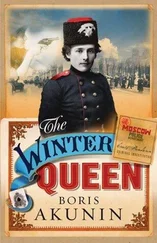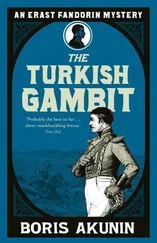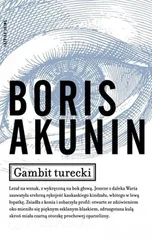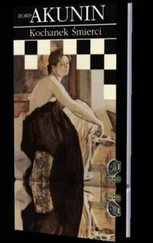I touched my forehead and felt a substantial bump. Well, serve me right.
‘But are there no leads at all then?’ I asked, my voice trembling with awareness of the gravity of my mistake.
‘Now all we can do is put our trust in Mademoiselle Declique. I am afraid I have run out of ideas. My Lady, tell Afanasii Stepanovich about your journeys to Lind’s place yesterday and today.’
‘What, have you already been to see him twice?’ I asked in amazement and turned towards the grey window, wondering what time it was.
‘Yes, today’s meeting was early this morning,’ Mademoiselle replied. ‘Will you permit me to speak French? It will be much quicker.’
And indeed, in five minutes she gave me an account of the events that had occurred during my enforced absence.
The previous day, Saturday, she had once again been summoned from the church by a note. The carriage (not the same one as the day before, but verymuch like it and also with boarded-up windows) was waiting on the next side street. The driver was the same – bearded, unspeaking, with his hat pulled down low over his eyes. Fifty-four minutes later (on this occasion Fandorin had given Mademoiselle a watch with phosphorescent hands) she was once again blindfolded and soon found herself in the same underground vault. This time they uncovered her eyes for a few moments so that she could take a brief glance at Mikhail Georgievich. The boy was lying with his eyes closed, but he was alive. The governess was forbidden to look around and all she saw was a bare stone wall dimly lit by a candle, and a chest that served His Highness as a bed.
On the morning of that day the whole procedure had been repeated. Doctor Lind had acquired an aigrette of diamonds and sapphires. During the few seconds that Mademoiselle was not blindfolded, she was able to take a closer look at the prisoner. He was still unconscious, had lost a lot of weight and his left hand was bandaged. Mademoiselle had touched his forehead and felt a strong fever.
Mademoiselle’s narrative broke off at that point, but she quickly took herself in hand.
‘How I wish this was all over,’ she said with a self-control that I found quite admirable. ‘Michel will not survive very long in conditions like that. He is a strong healthy child, but everything has its limits.’
‘Did you see Lind? Even out of the corner of your eye?’ I asked hopefully.
‘No. The blindfoldwas removed for no more than ten seconds and I was strictly forbidden to turn round. I only sensed that there were several men standing behind me.’
I felt an empty ache in the pit of my stomach.
‘So the search is no further forward at all?’
Mademoiselle and Fandorin exchanged glances in a way that seemed conspiratorial to me, and I felt a stab of almost physical pain. The two of them were together, a couple, and I had been left on the outside, alone.
‘We do have something,’ Fandorin declared with a mysterious air and, lowering his voice as if he were revealing some highly important secret, added: ‘I have taught Emilie to count the creaks made by the wheels.’
For a moment the only thing I understood was that he had called Mademoiselle Declique by her first name! Could their friendship really have gone that far? And only then did I attempt to penetrate the meaning of his words. I failed.
‘The creaks made by the wheels?’
‘Why yes. Any axle, even if it is perfectly lubricated, produces a creak which, if you listen closely, is a constant repetition of the same set of sounds.’
‘So what?’
‘One cycle, Ziukin, is a single revolution, a turn of the wheel. You only have to count how many times the wheel has turned in order to know how far the carriage has travelled. The wheels on carriages of the phaeton type preferred by the kidnappers are a standard size – in the metric system, they are a metre and forty centimetres in diameter. Therefore, according to the laws of geometry, the length of the circumference is equal to four metres and eighty centimetres. The rest is simple. Mademoiselle counts and remembers the number of revolutions from one corner to the next. It is easy to tell when the carriage turns a corner, because it leans either to the right or the left. We are not having the carriage followed, in order not to alarm the kidnappers, however, we do see the direction in which Emilie is driven away. After that everything d-depends on her alertness and her memory. And so,’ Fandorin continued in the voice of a teacher expounding a problem in geometry, ‘if we know the number and direction of revolutions, and also the d-distance between the corners, we can identify the place where they are hiding the child.’
‘Well, and have you identified it?’ I exclaimed in eager excitement.
‘Not so fast, Ziukin, not so f-fast,’ Fandorin said with a smile. ‘The mute driver deliberately does not follow a direct route, but turns and twists – evidently checking to see if anyone is on his tail. And so Emilie’s task is not a simple one. Yesterday she and I walked along the route taken by the carriage, checking her observations against the g-geography.’
‘And what did you discover?’ I asked, imagining Mademoiselle walking along the street, leaning on the armof her elegant escort, both of them serious and intent, united by the common cause, and meanwhile I was lying in bed like a useless block of wood.
‘Both times, after wandering around the side streets, the carriage came out onto Zubovsky Square. That is also confirmed by Emilie’s observations – at that point on the route she heard the sound of a large number of carriages and amurmur of voices.’
‘And after that?’
Mademoiselle looked round shamefacedly at Fandorin – this brief trusting glance made my heart ache once again – and said, as if she were making excuses for herself, ‘Monsieur Ziukin, yesterday I managed to remember eleven corners, and today thirteen.’ She screwed up her eyes and listed them hesitantly: ‘Twenty-two, left; forty-one, right; thirty-four, left; eighteen, right; ninety, left; fourteen, right; a hundred and forty-three, right; thirty-seven, right; twenty-five, right; a hundred and fifteen, right (and here, in the middle, at about the fiftieth turn of the wheels, the noise of the square); fifty-two, left; sixty, right; then right again, but I don’t remember how far. I tried very hard, but I lost track . . .’
I was astounded.
‘Good Lord, how did you manage to remember so many?’
‘Do not forget, my friend, that I am a teacher,’ she said with a gentle smile, and I blushed, uncertain as to howI should interpret that form of address and whether such familiarity was permissible in our relations.
‘But tomorrow it will all happen again, and you will lose track again,’ I said, assuming a stern air for the sake of good order. ‘The human memory, even the most highly developed, has its limits.’
I found the smile with which Fandorin greeted my remark most annoying. People smile in that way at the babbling of an innocent child.
‘Emilie will not have to remember everything from the very beginning. After Zubovksy Square, the carriage followed the same route both times, and the last corner that our scout definitely rememberedwas the junction of Obolensky Lane and Olsufievsky Lane. We do not know where the carriage went afterwards, but that spot has been identified with absolute certainty. From there to the final point is not very far – about ten or fifteen minutes.’
‘In fifteen minutes a carriage could travel a good ten versts in any direction,’ I remarked, piqued by Erast Petrovich’s arrogance. ‘Are you really planning to search such an immense area? Why, it’s larger than the whole of Vasilievsky Island!’
He smiled even more insufferably.
‘The coronation, Ziukin, is the day after tomorrow. And then we shall have to give Doctor Lind the Orlov and the game will be over. But tomorrow Emilie will set out again in a b-boarded-up carriage to pay the final instalment – some kind of tiara of yellow diamonds and opals.’
Читать дальше









